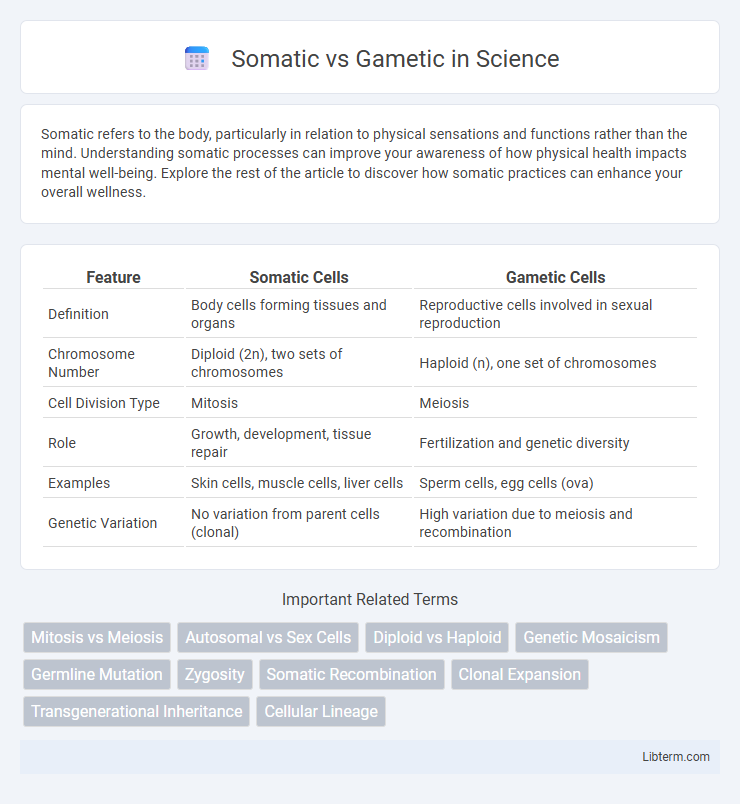Somatic refers to the body, particularly in relation to physical sensations and functions rather than the mind. Understanding somatic processes can improve your awareness of how physical health impacts mental well-being. Explore the rest of the article to discover how somatic practices can enhance your overall wellness.
Table of Comparison
| Feature | Somatic Cells | Gametic Cells |
|---|---|---|
| Definition | Body cells forming tissues and organs | Reproductive cells involved in sexual reproduction |
| Chromosome Number | Diploid (2n), two sets of chromosomes | Haploid (n), one set of chromosomes |
| Cell Division Type | Mitosis | Meiosis |
| Role | Growth, development, tissue repair | Fertilization and genetic diversity |
| Examples | Skin cells, muscle cells, liver cells | Sperm cells, egg cells (ova) |
| Genetic Variation | No variation from parent cells (clonal) | High variation due to meiosis and recombination |
Introduction to Somatic and Gametic Cells
Somatic cells are the body cells that form tissues and organs, containing a full set of chromosomes in diploid form, essential for growth, repair, and everyday functions. Gametic cells, or gametes, are specialized reproductive cells (sperm and egg) that carry half the genetic information in haploid form to enable sexual reproduction. Understanding the distinction between somatic and gametic cells is crucial for studying genetics, heredity, and cellular biology.
Defining Somatic Cells
Somatic cells are all body cells except for reproductive cells and carry a complete set of chromosomes, making them diploid. These cells undergo mitosis to enable growth, repair, and maintenance of tissues. Unlike gametic cells, somatic cells do not participate directly in sexual reproduction and contain identical genetic material in their nuclei.
Defining Gametic Cells
Gametic cells, also known as sex cells or gametes, are specialized reproductive cells that carry half the genetic information of an organism, enabling sexual reproduction. These haploid cells include sperm in males and eggs in females, each containing 23 chromosomes in humans, which fuse during fertilization to form a diploid zygote. Unlike somatic cells that are diploid and make up the body's tissues, gametic cells are essential for genetic diversity and inheritance across generations.
Key Differences Between Somatic and Gametic Cells
Somatic cells are diploid cells that make up most of an organism's body tissues, containing two sets of chromosomes inherited from each parent, while gametic cells are haploid reproductive cells with a single set of chromosomes. Somatic cells divide through mitosis, allowing for growth and tissue repair, whereas gametic cells undergo meiosis to produce genetically diverse haploid gametes for sexual reproduction. Unlike somatic cells, gametic cells contribute to genetic variation due to the crossing-over and independent assortment events during meiosis.
Chromosome Number: Diploid vs Haploid
Somatic cells contain a diploid chromosome number, meaning they have two complete sets of chromosomes, one from each parent, typically represented as 2n. Gametic cells, such as sperm and eggs, possess a haploid chromosome number, carrying only a single set of chromosomes (n), which is essential for maintaining species-specific chromosome numbers after fertilization. This distinction ensures genetic stability across generations through sexual reproduction.
Functions and Roles in Organisms
Somatic cells perform essential functions in growth, development, and tissue repair, maintaining the body's structure and metabolic activities, while gametic cells are specialized for reproduction, carrying genetic information to offspring through gametes like sperm and eggs. Somatic cells divide by mitosis to ensure genetic consistency across body tissues, whereas gametic cells undergo meiosis to reduce chromosome number by half, enabling genetic diversity in sexual reproduction. The distinct roles of somatic and gametic cells are crucial for organismal survival and propagation, balancing maintenance with heredity.
Cell Division: Mitosis vs Meiosis
Somatic cells undergo mitosis, a cell division process producing two genetically identical diploid daughter cells, essential for growth and tissue repair. Gametic cells are produced through meiosis, which reduces the chromosome number by half, generating four genetically diverse haploid cells for sexual reproduction. Mitosis maintains chromosomal stability, while meiosis introduces genetic variation through homologous recombination and independent assortment.
Importance in Genetic Inheritance
Somatic cells contain diploid chromosomes essential for bodily functions, while gametic cells are haploid, carrying half the genetic information crucial for sexual reproduction. The fusion of gametes during fertilization restores the diploid chromosome number, enabling genetic inheritance and variation. This process ensures the transfer of genetic traits from parents to offspring, maintaining species continuity.
Implications in Genetic Disorders
Somatic mutations affect non-reproductive cells and can lead to diseases like cancer but are not inherited by offspring, whereas gametic mutations occur in reproductive cells and can be passed to future generations, causing hereditary genetic disorders. Understanding the distinction is crucial for diagnosing and managing conditions such as somatic mosaicism in cancer or germline mutations responsible for inherited diseases like cystic fibrosis or Huntington's disease. Genetic counseling often relies on identifying whether mutations are somatic or gametic to assess disease risk and inform family planning decisions.
Summary and Conclusion
Somatic cells constitute the majority of an organism's body, containing diploid chromosome sets essential for growth and maintenance, while gametic cells are specialized reproductive cells with haploid chromosome sets crucial for sexual reproduction. Mutations in somatic cells affect only the individual, whereas mutations in gametic cells can be inherited by offspring, influencing genetic variation. Understanding the distinctions between somatic and gametic cells is vital for studies in genetics, developmental biology, and hereditary disease research.
Somatic Infographic

 libterm.com
libterm.com